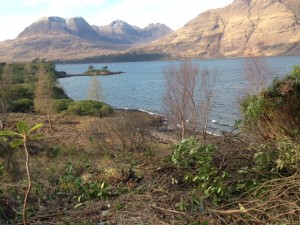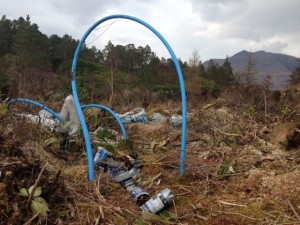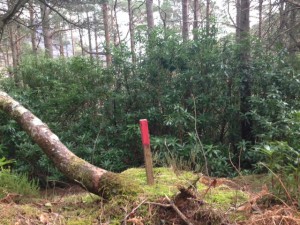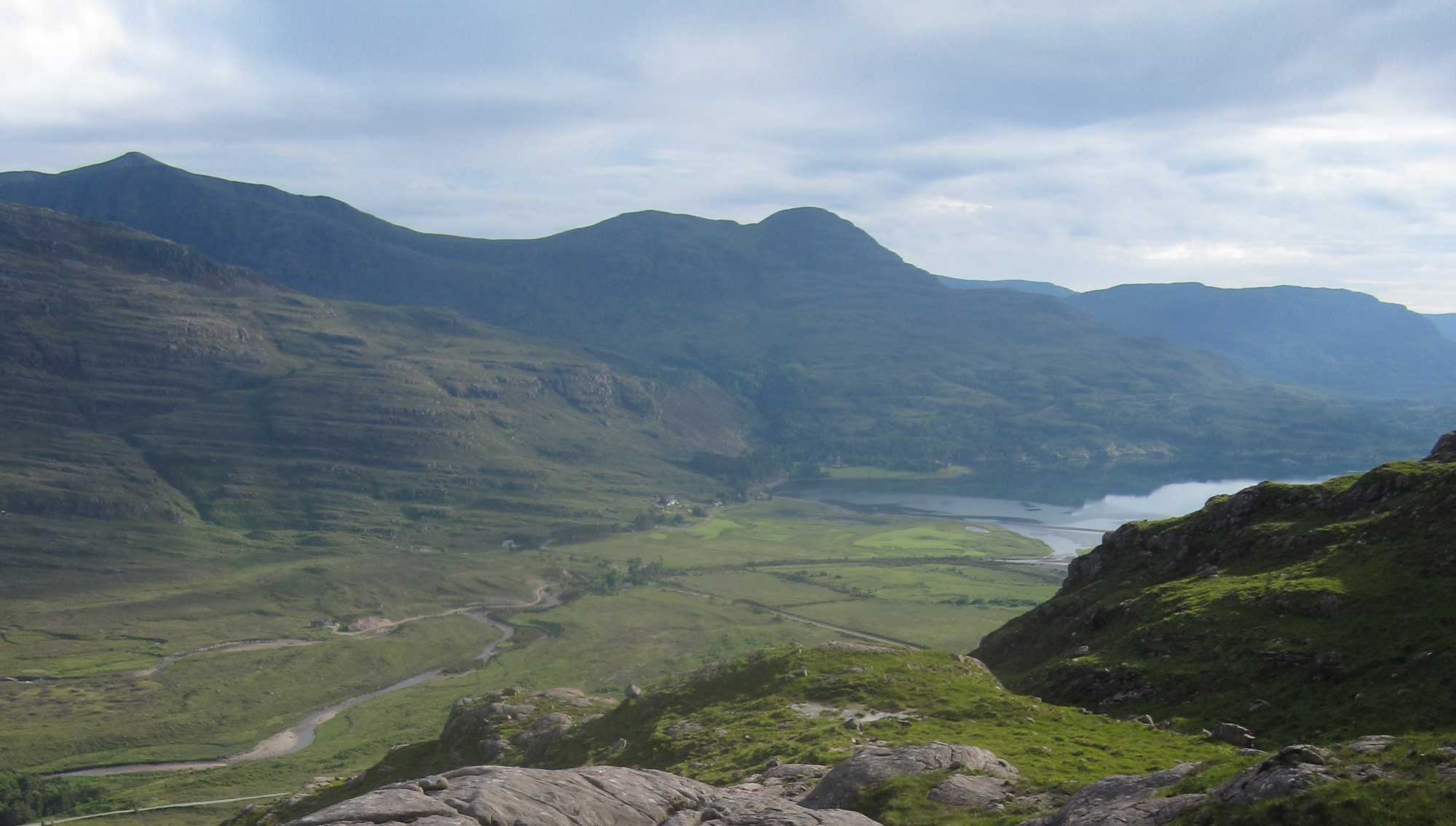Apologies if I have been a wee bit quiet on the blogging front. Rather embarrassingly for an environmental journalist, I have been involved in a major deforestation project.
I have spent the winter on the Ben Damph Estate in Wester Ross, which is clearing 90 hectares of rhododendron ponticum.
It has given me little time to write except for an expose of Ikea in the Sunday Times, a radio programme for the BBC, and a personal project about my mother that led to being on Woman’s Hour.
But the real reason I have not written is because rhododendrons are such a tangled mess, I didn’t really know where to start. It sounds so easy; just a few shrubs that can easily be chopped down. You have obviously not met rhododendron ponticum, otherwise known as the most damaging non-native terrestrial plant in the UK.
History
The invasive species properly arrived in Britain with the Victorians. The plant hunters brought the pretty evergreen shrubs back from the Himalayas as an attractive garden plant and game cover. Like so many grand ideas of that time it went horribly wrong. The rhododendrons thrived in our damp climate and took over wild landscapes in England, Scotland and Wales.
In Wester Ross the plants spread from the manicured gardens of the local hunting lodge to the iconic landscape of the Torridon hills. Today the green fuzz chokes the magnificent landscape, standing out against the more subtle colours of the winter hills. Nothing lives under the thick green canopy – not even a spider’s web.
Ben Damph Estate, like many of the surrounding landowners in a Special Area of Conservation including the National Trust, has been asked by Europe and the Scottish Government to get rid of rhododendrons. The programme is being administered by the Forestry Commission.
European-wide eradication programme
The work started last autumn with a fantastic machine called a mulcher, basically a caterpillar truck with a huge arm on the front that chews up the rhododendrons and spits out the bark. Unfortunately, after clearing 9 hectares, this metal dinosaur eventually lost some of its teeth on the Torridonian sandstone (it is 500 million years old afterall) and had to be retired.
Next came the chemical onslaught. The one thing that actually kills rhododendrons is napalm – famously used by the US military in Vietnam to clear the forest. Obviously one can’t use that here. Injecting glyphosate (known to many gardeners as Roundup) into trunks is a far more environmentally friendly option since it only kills the tree in question. Smaller bushes can also be sprayed.
But most of the rhododendron clearance around Wester Ross is classed as “manual difficult”. Now when I say difficult, I mean Torridonian difficult. Gangs from the local area and Bulgaria are chainsawing down the rhododendrons and burning the brash. Bear in mind the rhododendrons are on rocks, bog or cliffs and the weather is generally raining, hailing or raining and hailing. The larger logs are being saved to burn for fuel. Trees for Life also bravely cleared a small area by hand using bow saws and loppers.
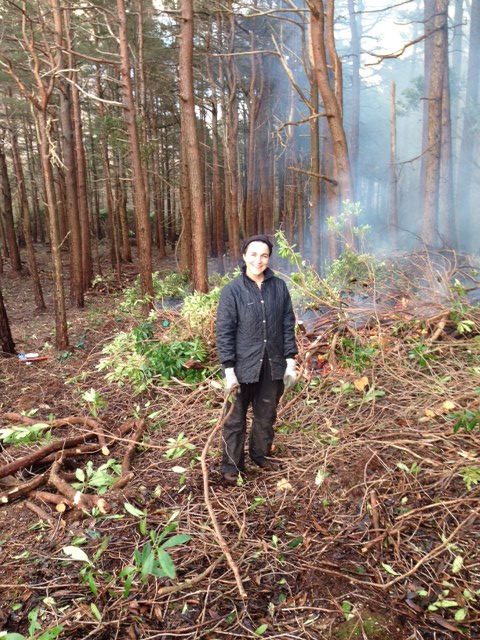
Dragging rhododendrons
The clearance has meant the sound of chainsaws all day and smoke billowing across the loch, but local people have welcomed the eradication of rhododendrons. Many of the views out to Liathach and Ben Alligin opened up by the clearance have not been seen for 100 years and the contours of the landscape are a revelation. Scots Pine and willow, that have been suffocated for decades, are finally taking a breath. Some interesting artefacts have also been discovered hiding in the rhododendrons including deer bones, old cars and a cannabis factory.
Thanks to the hard work of all involved the clearance is making progress but it is just the beginning. One flowering bush can produce millions of seeds so while everyone else is admiring the flowers this spring I shall be worrying about where seedlings are going to blow…
What you can do to help
The first rhododendron clearance project in the UK started in 1963 – it hasn’t finished yet. It is a very difficult plant to get rid of, which is why I get so annoyed by people who still want to plant ponticum in their gardens. I was even forced to channel my inner Disgusted of Tunbridge Wells in a grumpy letter to the Daily Telegraph.
Ultimately, getting rid of an invasive species will need everyone to get involved. Whether it is choosing to plant a non-invasive rhododendron in your garden or knowing how to spot a baby rhododendron on a walk and dig it up – or at least report it via the internet.
But the really interesting question is what will emerge now the rhododendrons are gone? Nature abhors a vacuum and already robins are digging around the cleared areas for fresh insects. It is hoped native trees will return – if the deer are kept out – and perhaps mammals like pine martens. Much of it will depend on how the rhododendrons are cleared – and kept down. New methods like ‘lever and mulch’, where the trees are simply pulled out of the ground and left to rot, claim to stop baby rhododendrons regrowing as the ground is covered in brash. Some people claim that the dead rhododendron leaves poison the ground and nothing grows for decades afterwards. Others are hoping for Caledonian Forest regrowing within years through planting or an explosion of “rewilding”.
Ben Damph Estate is trying a number of methods. For now I am back down south getting back into writing about climate change, but I shall be keeping in touch with the clearance project and try to keep you updated. You can also follow the work via Ben Damph Estate on Facebook and @bendamph on Twitter. Ten red ‘Photography Stakes’ around the estate will show how the landscape is changing over time. The idea is that people take photographs in the same spot and then they can be posted on albums on Facebook so that everyone can see how the landscape is changing.
I have learnt many things living in the Highlands, mostly about the need for good waterproofs and a sense of humour, but most of all about how difficult rhododendrons are to kill. I am still learning about this triffid so please get in touch to vent your hatred (or indeed love) of rhododendron ponticum in the comment boxes below.

